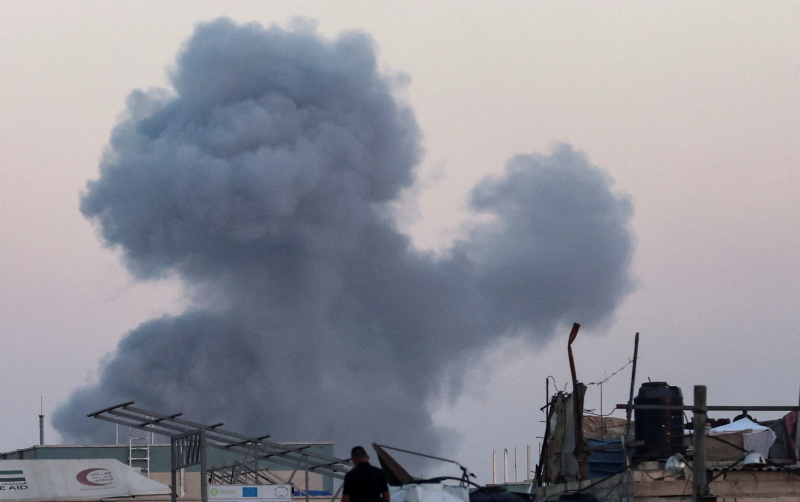Politics
Ceasefire Resumes as Airstrikes Kill 26 in Gaza Conflict

Aid is set to resume in Gaza after a series of Israeli airstrikes killed at least 26 people, including women and children, according to local health authorities. This decision followed pressure from the United States, as tensions escalated between Israel and Hamas over alleged ceasefire violations. The ceasefire, which took effect on October 10, 2024, had already faced challenges, with both sides accusing each other of breaching the agreement.
Israeli military operations targeted Hamas positions across Gaza in response to an anti-tank missile attack that resulted in Israeli casualties. The strikes included hits on a former school being used as a shelter for displaced persons in Nuseirat, according to residents. The armed wing of Hamas claimed it remained committed to the ceasefire but refuted accusations regarding clashes in Rafah.
Israeli Prime Minister Benjamin Netanyahu stated he had instructed the military to respond decisively to what he described as Hamas’ violations of the ceasefire. An Israeli security official indicated that the transfer of aid into Gaza had been halted due to these violations. However, another official later confirmed that aid would resume on Monday, following diplomatic efforts from U.S. officials, including Donald Trump‘s envoy, Steve Witkoff, and son-in-law Jared Kushner.
The airstrikes prompted panic among residents, leading some Palestinians to rush to local markets in Nuseirat for supplies, while families fled from Khan Younis amid fears that the truce might collapse. The situation recalls Israel’s military responses to violations of ceasefires in the past, such as in late 2024 when tensions with Hezbollah escalated following similar accusations.
Complex Dynamics of the Ceasefire
The fragile ceasefire has been marred by ongoing disputes over the handling of hostages. Hamas recently released 20 living hostages but has been slow to return the bodies of deceased captives, which Israel argues is a critical component of the ceasefire agreement. Israeli Defense Minister Israel Katz emphasized that any attempt to breach the agreed boundaries would result in military action.
Hamas has countered by outlining its own grievances, alleging that Israeli actions have resulted in the deaths of 46 people and hindered essential supplies from reaching the enclave. As tensions mount, Israel announced that the Rafah border crossing, which connects Gaza to Egypt and serves as a vital route for humanitarian aid, would remain closed until Hamas fulfills its obligations under the ceasefire.
The Rafah crossing has largely been shut since May 2024, significantly constraining the flow of aid into Gaza. While some aid had increased through alternative routes since the ceasefire began, the United Nations has indicated that the humanitarian needs within the enclave remain dire, with hundreds of thousands of people suffering from food insecurity.
The Path Ahead for Gaza
The ceasefire agreement includes provisions for ramping up humanitarian aid, yet it is clear that significant challenges lie ahead for achieving lasting peace in the region. Key issues, such as disarming Hamas, establishing future governance in Gaza, and the potential creation of an international stabilization force, remain unresolved.
As the situation develops, the international community watches closely, hoping for a resolution that will alleviate the suffering of civilians caught in the conflict. The return of aid is a crucial step, but the complex dynamics of the relationship between Israel and Hamas will require ongoing dialogue and commitment from both sides to ensure a sustainable peace.
-

 World1 week ago
World1 week agoPrivate Funeral Held for Dean Field and His Three Children
-

 Top Stories2 weeks ago
Top Stories2 weeks agoFuneral Planned for Field Siblings After Tragic House Fire
-

 Sports3 months ago
Sports3 months agoNetball New Zealand Stands Down Dame Noeline Taurua for Series
-

 Entertainment3 months ago
Entertainment3 months agoTributes Pour In for Lachlan Rofe, Reality Star, Dead at 47
-

 Entertainment2 months ago
Entertainment2 months agoNew ‘Maverick’ Chaser Joins Beat the Chasers Season Finale
-

 Sports3 months ago
Sports3 months agoSilver Ferns Legend Laura Langman Criticizes Team’s Attitude
-

 Sports1 month ago
Sports1 month agoEli Katoa Rushed to Hospital After Sideline Incident During Match
-

 World3 weeks ago
World3 weeks agoInvestigation Underway in Tragic Sanson House Fire Involving Family
-

 Politics2 months ago
Politics2 months agoNetball NZ Calls for Respect Amid Dame Taurua’s Standoff
-

 Top Stories2 weeks ago
Top Stories2 weeks agoShock and Grief Follow Tragic Family Deaths in New Zealand
-

 Entertainment3 months ago
Entertainment3 months agoKhloe Kardashian Embraces Innovative Stem Cell Therapy in Mexico
-

 World4 months ago
World4 months agoPolice Arrest Multiple Individuals During Funeral for Zain Taikato-Fox



















